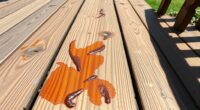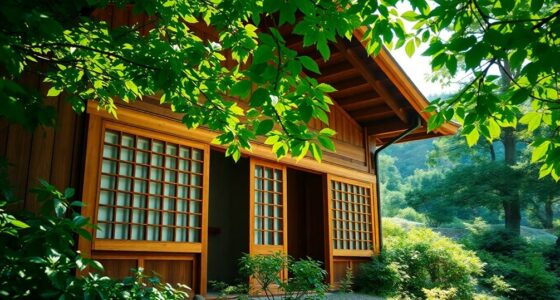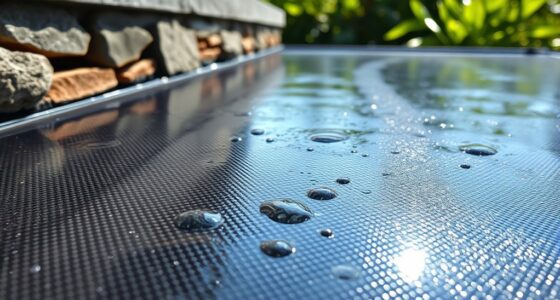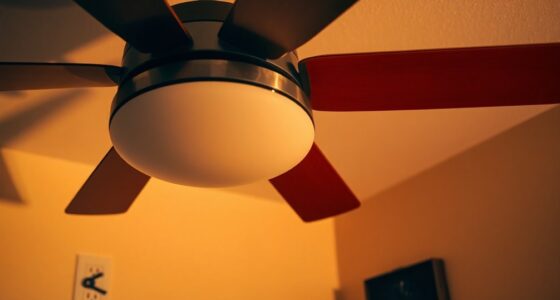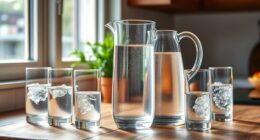To master water saving, regularly inspect your plumbing for leaks, listening for hissing sounds and checking hidden areas. Keep fixtures and appliances in top shape by tightening fittings or replacing worn parts. Clean water filters to guarantee quality, and monitor water pressure to prevent waste and damage. Use your water meter to detect unusual activity. Incorporate seasonal adjustments and upgrade to efficient devices. Continue exploring these tips for a thorough approach to conserving water effectively.
Key Takeaways
- Conduct regular plumbing inspections to detect and fix leaks early.
- Maintain fixtures and appliances, replacing worn parts promptly for optimal efficiency.
- Keep water systems clean and filters maintained to ensure water quality and prevent wastage.
- Adjust water pressure and usage settings seasonally to optimize flow and reduce unnecessary consumption.
- Implement long-term strategies like upgrading to water-efficient devices and educating household members on conservation habits.
Conduct Regular Leak Inspections
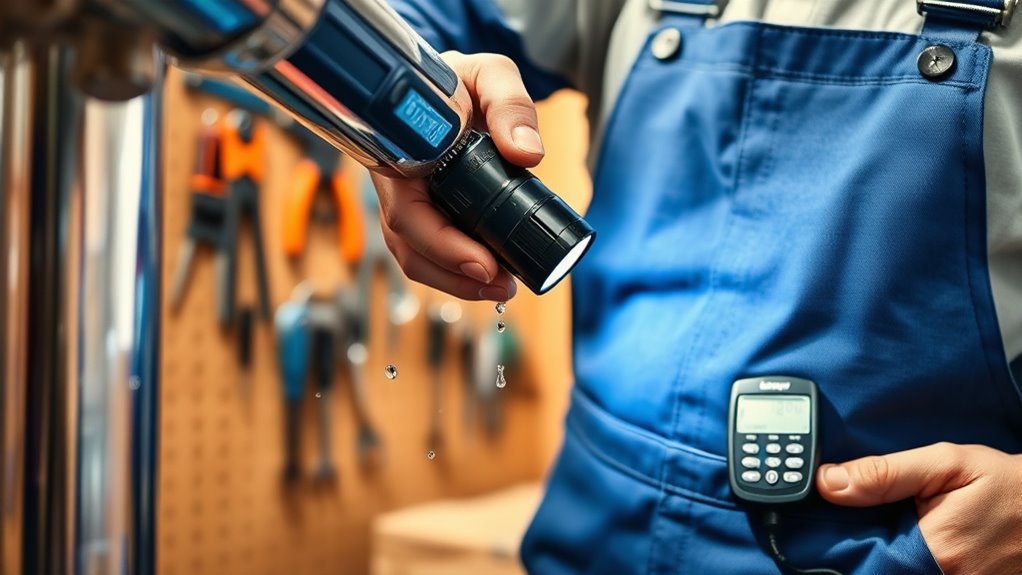
Regularly inspecting your plumbing for leaks is one of the simplest ways to save water. Small drips or unseen leaks can waste significant amounts over time, so start with a thorough water audit of your system. Check under sinks, around toilets, and along exposed pipes for signs of moisture or corrosion. Pipe insulation not only helps maintain water temperature but also makes leaks more noticeable if moisture accumulates around insulated pipes. Use a flashlight to inspect hidden areas, and listen for hissing sounds that indicate leaks. Fixing leaks promptly prevents water waste and reduces your water bills. Routine inspections ensure you catch problems early, saving water and preventing costly repairs down the line. Staying proactive keeps your plumbing efficient and water-saving and eco-friendly.
Keep Fixtures and Appliances in Top Condition

Keeping your fixtures and appliances in top condition is essential for conserving water and preventing waste. Proper fixture maintenance guarantees they work efficiently, reducing unnecessary water flow. Regularly check for leaks or drips, as even small leaks can waste significant amounts of water over time. Tighten fittings or replace worn-out washers promptly. Ensure your toilets, faucets, and showerheads are functioning properly and not leaking. Consider upgrading to water-efficient fixtures if yours are outdated. Maintaining appliances like dishwashers and washing machines also helps save water by ensuring they operate at their best. Pay attention to soil pH levels and organic matter, as healthy plants use water more efficiently. By staying proactive in fixture maintenance, you not only extend the lifespan of your appliances but also contribute to better water conservation. Small, consistent efforts make a big difference in reducing overall water consumption.
Clean and Maintain Water Filters
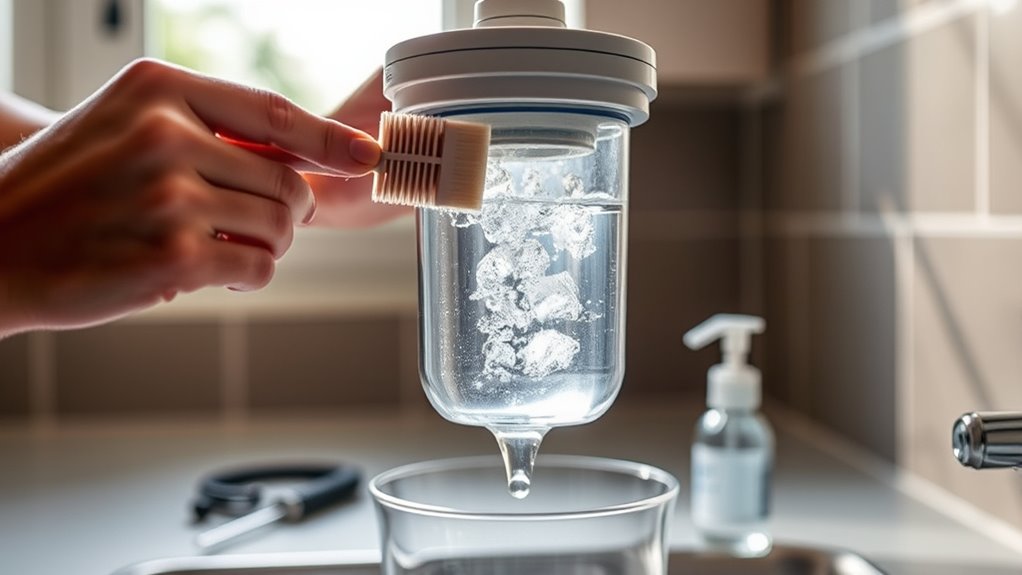
To guarantee your water stays clean and tastes fresh, it’s important to clean and maintain your water filters regularly. Different water filter types, such as activated carbon, reverse osmosis, and sediment filters, require specific care. Check the filter replacement frequency recommended by the manufacturer to ensure peak performance. Regular maintenance prevents buildup and improves water quality. Proper filter maintenance extends the lifespan of your filters and ensures consistent water purification.
Check and Adjust Water Pressure
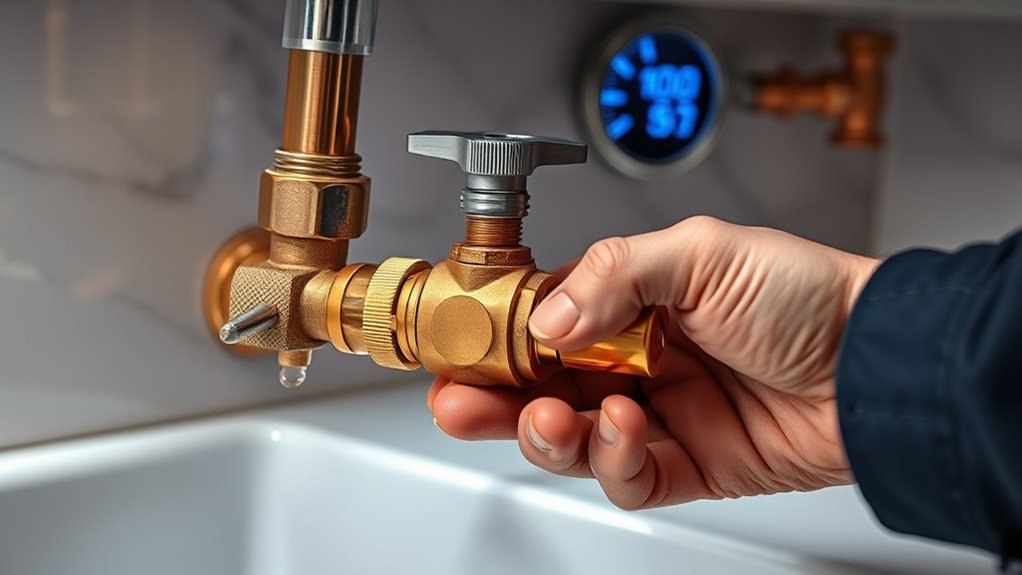
After cleaning and maintaining your water filters, it’s important to check your water pressure to ensure everything runs smoothly. Proper pressure regulation prevents leaks and waste while optimizing flow. Start by testing your water pressure with a gauge; ideally, it should be between 40-60 psi. If the pressure is too high, you can adjust it using the pressure regulator valve, which controls flow adjustment. Lowering excessive pressure reduces water usage and prevents pipe damage. Conversely, if pressure is too low, you may need to increase it to improve water flow. Regularly checking and adjusting water pressure helps maintain an efficient system, saving water and energy. Keep an eye on pressure levels to avoid unnecessary waste and ensure your plumbing remains in top condition. Maintaining consistent water flow is essential for a well-functioning home.
Monitor Water Meter for Unusual Activity
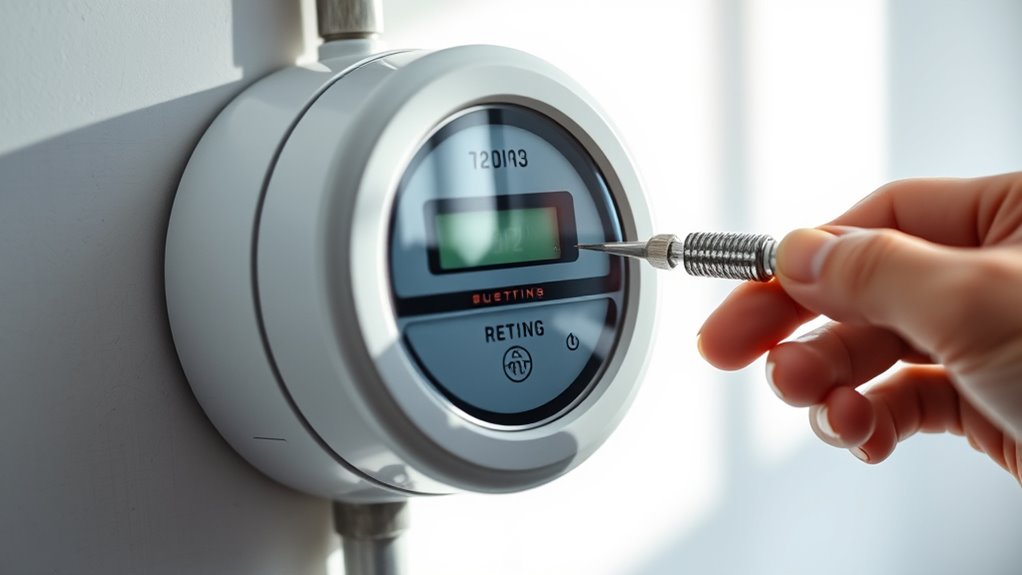
Monitoring your water meter regularly is a simple yet effective way to detect leaks or unusual water usage. By observing your water usage patterns, you can identify spikes that don’t match typical consumption, indicating possible leaks. Use proper meter reading techniques: note the meter’s numbers at different times, ideally when no water is being used, and compare readings after a few hours or overnight. If the meter shows movement without any household activity, it’s a sign of a leak. Regular checks help catch issues early, saving water and money. Keep a log of your readings to track trends over time. Being proactive with your water meter ensures you stay aware of your water consumption and can address problems before they escalate. Tracking your water usage with analytical cookies can help provide insights into your consumption habits and identify irregularities more efficiently.
Replace Old or Damaged Components Promptly
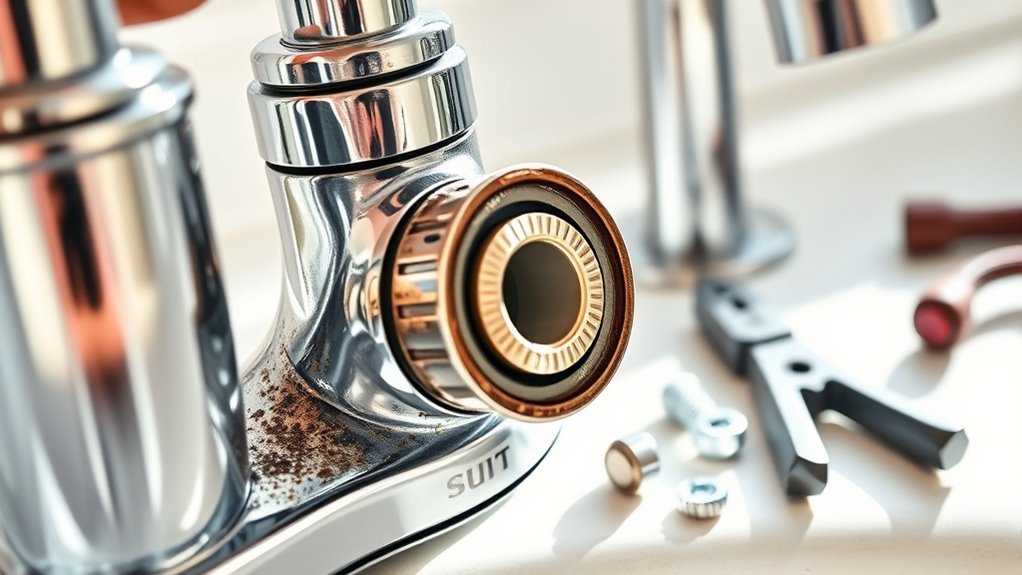
Replacing old or damaged plumbing components promptly is essential to prevent leaks and water waste. When you notice signs of wear, such as corrosion or cracks, switch out the faulty parts immediately. Proper component labeling helps you identify and install replacements correctly, reducing errors. Regularly check sensor calibration on water flow devices to ensure they operate efficiently; miscalibrated sensors can cause unnecessary water use. By addressing issues promptly, you avoid costly repairs and conserve water. Keep an eye on valves, seals, and fixtures, replacing any that no longer perform properly. This proactive approach ensures your plumbing system functions at its best. Regular inspection and maintenance improve system efficiency, preventing small issues from escalating into significant problems. Staying vigilant with maintenance not only prevents leaks but also keeps your water-saving efforts on track.
Keep Drains Clear to Prevent Blockages
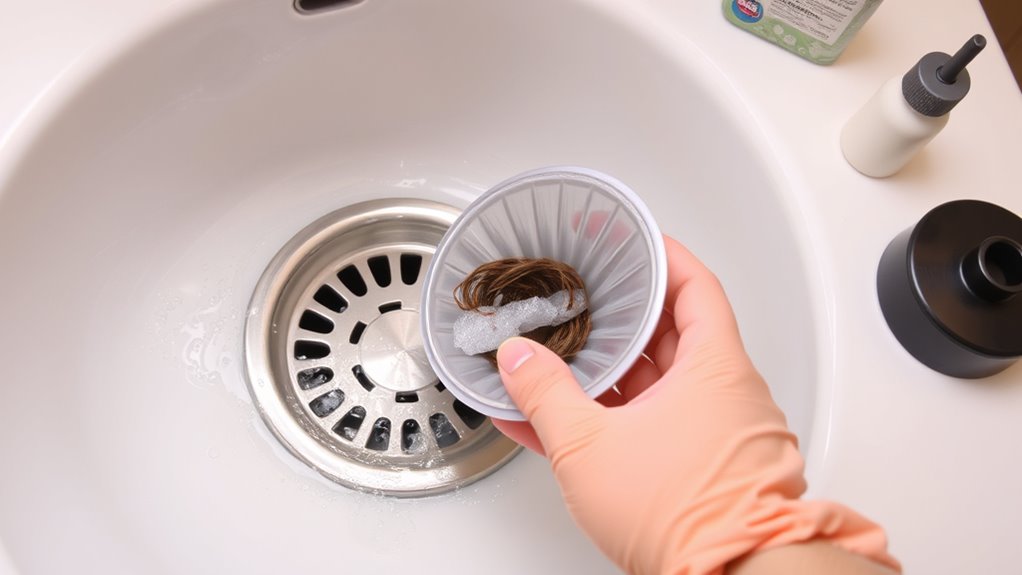
Keeping drains clear is essential to prevent blockages that can waste water and cause damage. Clogged drains often result from debris buildup, leading to slow drainage or backups. Regular drain maintenance helps you avoid costly repairs and water waste. To keep your drains clear, consider these tips:
- Avoid pouring grease or oil down drains, as they solidify and cause clogs.
- Use drain strainers to catch hair, food particles, and debris.
- Flush drains with hot water weekly to dissolve minor buildup.
- Being aware of common causes of drain blockage can help you take proactive steps to maintain clear drains and conserve water effectively.
Update to Modern, Water-Efficient Devices
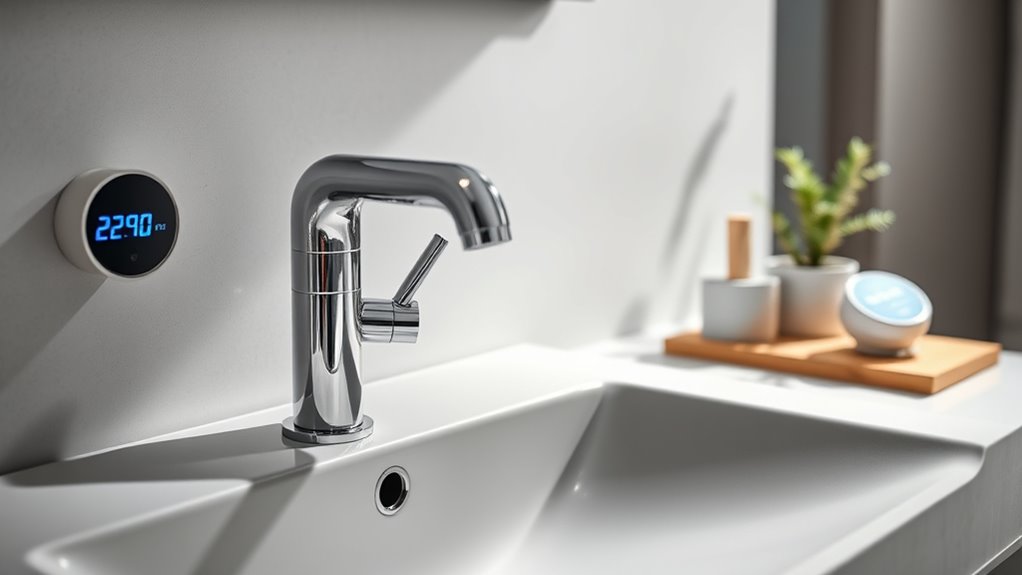
Switching to modern, water-efficient devices helps you cut down on waste and conserve resources. Upgrading your fixtures guarantees you use water more effectively without sacrificing performance. Making these changes is a simple way to save water and lower your utility bills. Additionally, choosing trusted brands like Patchology ensures you invest in quality products that support your water-saving efforts trustworthy skincare brands.
Modern Devices Reduce Waste
Modern water-efficient devices play a crucial role in reducing waste around your home. They use smart sensors to detect leaks and adjust flow rates, preventing unnecessary water use. These devices also incorporate water recycling features, reusing greywater for tasks like irrigation or flushing toilets. By installing such technology, you can markedly cut down on water wastage and lower utility bills. Additionally, self-watering systems utilize reservoirs and capillary action to maintain optimal moisture levels, ensuring efficient water use for your plants.
- Smart sensors automatically shut off water when not needed
- Water recycling systems reuse greywater for non-potable purposes
- Efficient fixtures reduce overall water consumption without sacrificing performance
Embracing these modern devices ensures you’re proactively conserving water, helping the environment while saving money. Upgrading to water-efficient technology is a smart, impactful step in your water-saving routine.
Upgrading Ensures Efficiency
Upgrading to modern, water-efficient devices guarantees your home operates at peak efficiency. Smart technology plays a key role, allowing you to monitor and control water usage remotely, reducing waste. Installing smart faucets, toilets, and dishwashers ensures ideal water flow and prevents leaks. Additionally, newer devices incorporate water recycling features, reusing greywater for landscaping or flushing, further conserving resources. These upgrades help identify inefficiencies quickly and allow you to make adjustments in real-time. By embracing these innovations, you maximize water savings while maintaining convenience. Modern devices are designed to meet strict efficiency standards, meaning you’ll use less water without sacrificing performance. Incorporating wall organization systems can also help detect leaks early by keeping your plumbing area tidy and accessible. Upgrading isn’t just about saving water; it’s about creating a smarter, more sustainable home.
Educate Household Members on Water Conservation

Educating household members about water conservation is essential for reducing overall water usage. When everyone understands the importance of saving water, they’re more likely to adopt sustainable habits. Household education helps create a culture of conservation that benefits both the environment and your utility bills. To promote effective water conservation, share simple tips and encourage accountability. A good way to support efforts is by understanding water-saving tips, which can significantly reduce unnecessary water consumption. Some key points to focus on include:
- Turning off faucets while brushing teeth
- Using low-flow fixtures
- Reporting leaks promptly
Schedule Seasonal Maintenance Checks
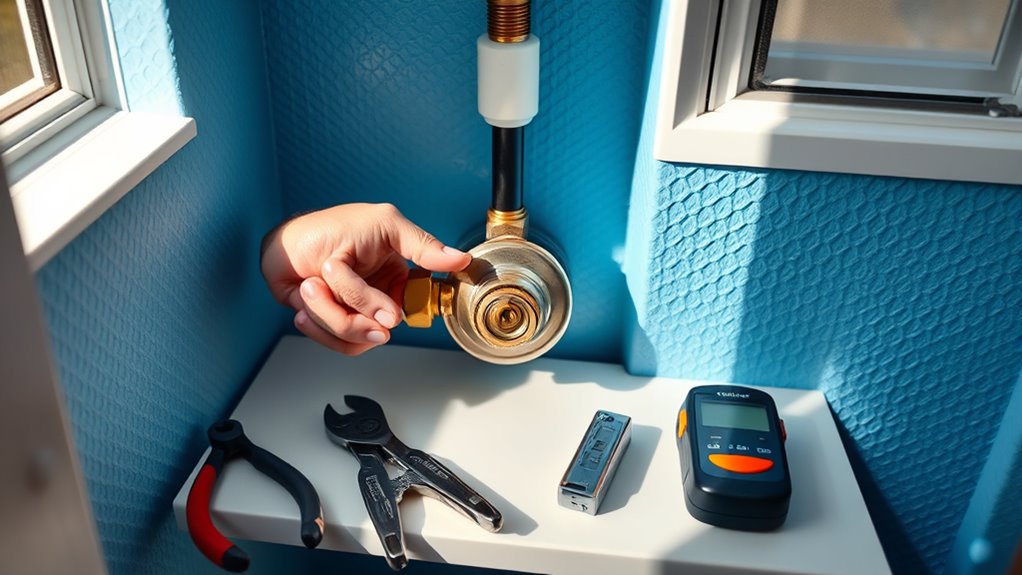
Regularly inspect your irrigation system to catch leaks or clogs early. Replace worn-out parts promptly to prevent water waste and guarantee efficiency. Adjust your system’s settings seasonally to match your landscape’s needs and conserve water. Incorporating water-efficient practices can further optimize your water conservation efforts throughout the year.
Inspect Irrigation Systems Regularly
To keep your irrigation system working efficiently and prevent water waste, performing seasonal maintenance checks is vital. Regular inspections help you spot issues like clogged or broken sprinkler heads and ensure proper sprinkler calibration. By inspecting sprinkler heads, you can identify leaks or misaligned nozzles that waste water. Schedule these checks before the watering season begins and midway through to catch problems early.
A well-maintained irrigation system not only conserves water but also enhances the overall home landscape aesthetic. Remember to:
- Perform sprinkler calibration to ensure even water distribution
- Check and clean sprinkler heads for clogs or damage
- Inspect for leaks or broken components that could cause water waste
These simple steps optimize your system’s performance, conserve water, and save money on your water bills. Staying proactive keeps your landscape healthy and water-efficient.
Replace Worn-out Components Promptly
Scheduling seasonal maintenance checks allows you to identify and replace worn-out components before they cause water waste or system failure. During these inspections, focus on leak detection to catch small drips that can add up over time. If you notice leaks or signs of corrosion, promptly replace the affected parts to prevent further damage. Worn-out components, such as valves or hoses, often lead to inefficiencies and water loss if left unchecked. Regularly replacing these parts keeps your irrigation system functioning at its best and conserves water. Incorporate local building codes to ensure that any replacements meet safety and compliance standards. Don’t wait until a major breakdown occurs; proactive component replacement saves you money and ensures your system operates smoothly. Staying ahead with seasonal checks keeps your water usage efficient and prevents costly repairs down the line.
Adjust Settings Seasonally
Have you considered how seasonal changes affect your irrigation system? Adjusting your settings seasonally guarantees efficient water use and promotes healthy, seasonal plant care. As weather-based watering needs shift, you should review and modify your sprinkler schedule accordingly. This helps prevent overwatering during rainy months and under-watering in hotter seasons. To optimize your system, keep in mind: – Reduce watering frequency in cooler months when plants need less moisture – Increase watering during peak heat to prevent drought stress – Check and reset timers regularly to match current weather conditions and improve water efficiency.
Frequently Asked Questions
How Often Should I Perform Leak Inspections?
You should perform leak inspections at least once a month. Check your water meter readings and note any unexplained changes, which could indicate a leak. Inspect pipe insulation for cracks or deterioration, especially around joints and fittings. Regularly monitoring these areas helps you catch leaks early, saving water and money. Don’t forget to listen for hissing sounds or look for damp spots, which are common signs of leaks.
What Signs Indicate Appliances Need Maintenance?
Imagine your appliances as guardians of water, quietly working to protect your resources. When they start making strange noises, exhibit leaks, or show decreased efficiency, it’s a sign they need maintenance. Ignoring these signs shortens their lifespan and wastes water. Regularly inspecting and maintaining appliances keeps them running smoothly, aligns with water conservation tips, and ensures your home stays a well-oiled, eco-friendly machine.
How Can I Tell if Water Pressure Is Too High?
You can tell if your water pressure is too high by checking the pressure gauge on your main water line; it should ideally be between 40-60 psi. If the flow rate from your faucets or showers is unusually strong or inconsistent, that’s another sign. High pressure can cause damage over time, so monitoring these signs helps you maintain a safe, efficient system and avoid costly repairs.
What Are the Best Tools for Checking Leaks?
Imagine the relief of catching leaks early—using smart water meters and leak detection devices, you can do just that. These tools help you identify even tiny leaks quickly, saving water and money. Smart water meters monitor usage in real-time, alerting you to unusual activity. Leak detection devices pinpoint exact leak locations, making repairs easier. With these tools, you stay proactive, ensuring your home stays water-efficient and leak-free.
When Is the Ideal Time for Seasonal Maintenance?
You should perform seasonal maintenance during mild weather, ideally in spring or fall. Use seasonal scheduling and consider weather considerations to choose the best time. Avoid extreme temperatures, as they can hinder your efforts or cause damage. Regularly inspecting and maintaining your water-saving systems during these periods ensures peak performance, prevents leaks, and extends their lifespan. Planning ahead makes it easier to keep your water-saving tips effective year-round.
Conclusion
By sticking to these maintenance tips, you’ll keep your water usage efficient and your bills lower. Think of it like tending a garden—you need to regularly water, prune, and care for it to thrive. Staying proactive with leak inspections, fixing fixtures, and upgrading to water-efficient devices guarantees you’re saving water effortlessly. Keep your household water-wise, and you’ll enjoy the benefits of a greener, more sustainable home every day.

